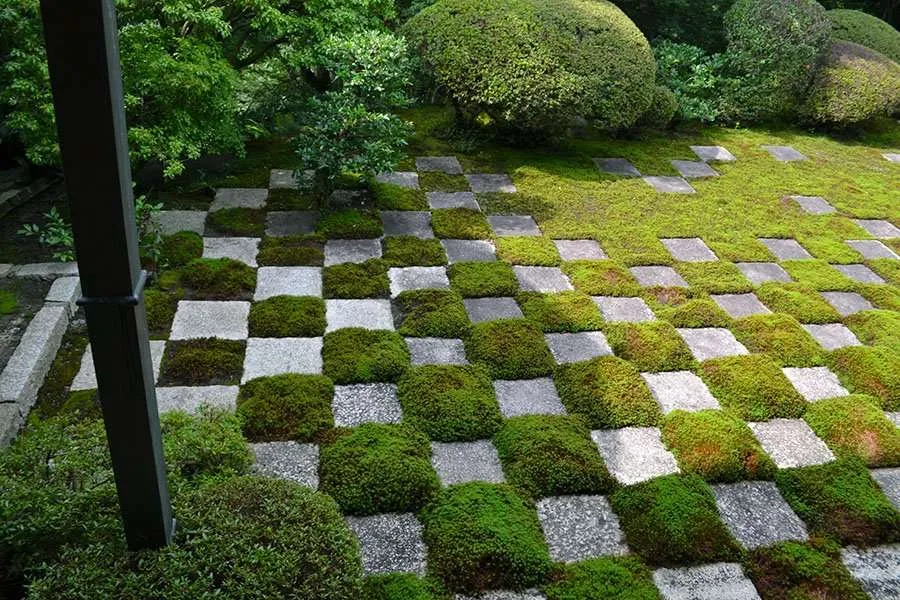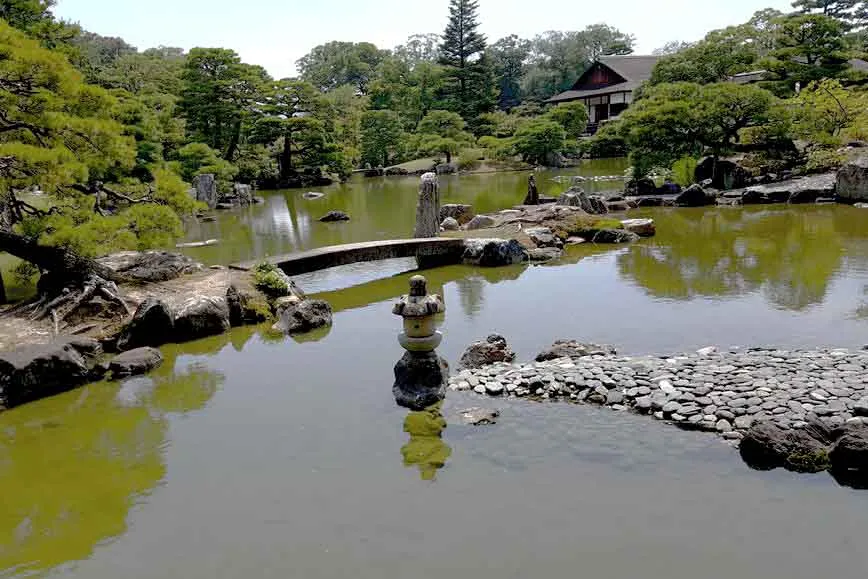What is karesansui (dry landscape) Zen rock garden? (1)
PART I: History of karesansui
What is karesansui?
枯山水 (karesansui or dry landscape) is one of traditional Japanese garden styles that denies water, presumably the most important element for any types of gardens. Where did the idea come from, and how did it evolve to become one of the most prominent wabi-sabi Zen cultures?
The history of the Japanese garden: Shinden zukuri and Jodo-shiki garden (8th ~ 12th century)
Shinden zukuri, ancient Japanese architecture style for aristocrats
The earliest Japanese garden style can be traced back to the Hei-an era (794 – 1185), during which gardens were designed as part of the “寝殿造り (shinden-zukuri)” style mansion lived in by aristocrats. The shinden-zukuri was a series of residential units that formed a shallow U-shape together with auxiliary buildings. The main unit, the shinden or the bedroom unit, was the main building found at the bottom of the U-shape (# 1 in the below example), which were connected with the sub-units using corridors. The entire building area surrounded the garden, most of which was a large pond with islands connected by the bridges.
The model of Higashi-sanjo-den, a typical shinden-zukuri mansion lived by an Hei-an aristocrat.
Consistent with the “作庭記,” the water body was the most important element in the shinden-zukuri garden. Aristocrats chose a site that was close enough to the river, and dug a creek to their site. The creek typically entered from the back of the building (which usually faced North-east), flowed under the corridors and poured into the pond that faced south.
The structure of shinden-zukuri, or traditional Japanese architecture in general, was supported by pillars and beams with no load-bearing walls. In absence of the fixed, sturdy walls, the house was semi-open to the surrounding environment and the residents could choose to leave the rooms open to outside, or to semi-closed using screens, partitions or furniture, depending on the weather or the activities. Buildings and gardens were designed as contiguous architecture, whose highlight was the garden view from the shinden, or the master bedroom.
The area in front of the shinden room was covered with white sand to be used for various activities, beyond which was the large pond with small islands connected by the bridges painted vermilion. The aristocrats often partied on the boats. The entire garden surrounding the pond usually echoed famous scenic places in China or in Japan.
In such an exquisite environment, aristocrats indulged in observing subtle changes in natural beauty, engaging in elusive, romantic relationships while playing the game of politics. (read more about the Hei-an culture and “nono no aware”)
The painting based on “The Tale of Genji (1008),” a story of the aristocrats who lived in the shinden-zukuri mansions during the Hei-an era.
Jodo shiki (style) garden
Ponds were also considered something that would bring people to another, higher world. Especially when the “Western Paradise (Jodo – a painless, suffering-less land where Buddhas are believed to go after their transcendence)” concept of Buddhism became popular, the Hei-an aristocrats sought to re-create the paradise in their garden. It was called Jodo-shiki (Jodo style) garden and is characterized by the horizontally expansive, calm water surface that looks peacefully beautiful against the smoothly curved hills/mountain ranges. The shinden-zukuri and Jodo-style garden have become the foundation of traditional Japanese garden.
The Motsu-ji temple was originally built in 850 in the historic Northern town of Hiraizumi in the Iwate Prefecture. It has one of the oldest surviving Jodo-shiki gardens. People dug a creek from the river called yari-mizu (left) to create a water-rich garden (right).
Images by houroumono via CC BY 2.0
The format of the Jodo-style became a foundation for the traditional Japanese garden, which continued to be expanded and refined as 池泉回遊式庭園 (chisen kaiyu-shiki teien – stroll-around-the-pond style garden). It placed a pond (often a complex-shaped body of water with small tributaries) at the center, and surrounded it with winding lanes, gazebos, tea houses and temples. As a water-rich country, Japan maintained the water-oriented garden style throughout its history, both before/after the emergence of kare-sansui.
If water was the central element for the traditional Japanese gardens, rocks were another critical feature. For example, the abovementioned text book, “作庭記 (garden design manual),” started with a statement:
石を立てんこと、まづ大旨をこころふべき也。
(The most important thing in erecting rocks is to have overarching design philosophy.)
Here, the author (there are multiple theories who that was) used the phrase “erecting rocks” to mean “designing a garden,” because rocks were such an important part of garden design. Indeed, the ancient Japanese worshiped “holy” rocks because they believed that they were visited by deities in nature. Rocks that carried natural solemnity were highly sought-after for religious uses, but were also used in gardens to express natural elements such as mountains, waterfalls, islands, animals and/or mythical/religious symbols. When kare-sansui emerged after the Hei-an era, rocks played a central role in the absence of water. Consistent with traditional garden design philosophy seen in the “作庭記 (garden design manual),” rocks were mostly used as found – no cutting, shaping nor polishing – to appreciate their naturally occurring appearance.
Left: The “holy” rocks were worshiped in ancient Japan. The Tsuzuki-ishi rock in Tono, Iwate Prefecture, Japan. image by kntrty via CC BY 2.0
Right: The rocks were used to express an island and a shore washed by heavy waves in Motsu-ji temple’s Jodo-style Garden. image by Tak1701d via CC BY-SA 3.0


































